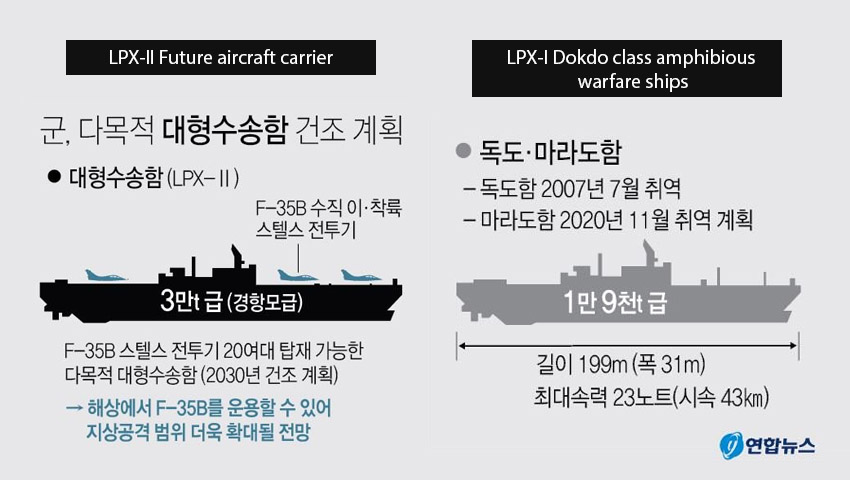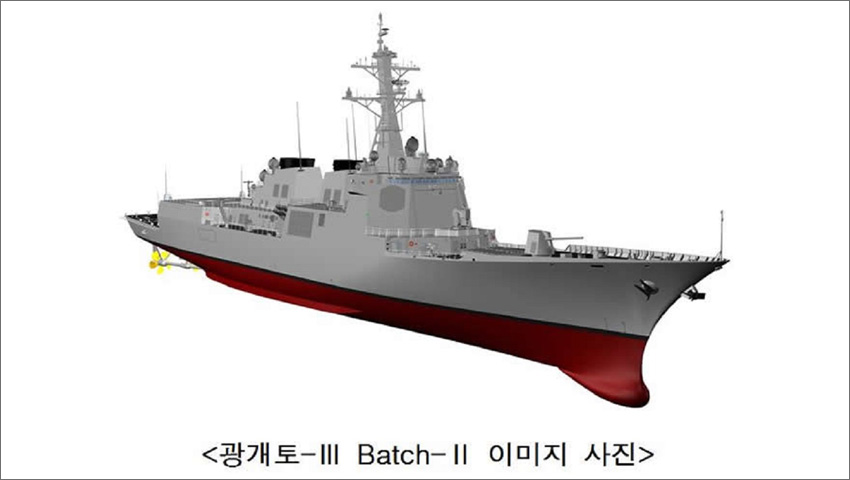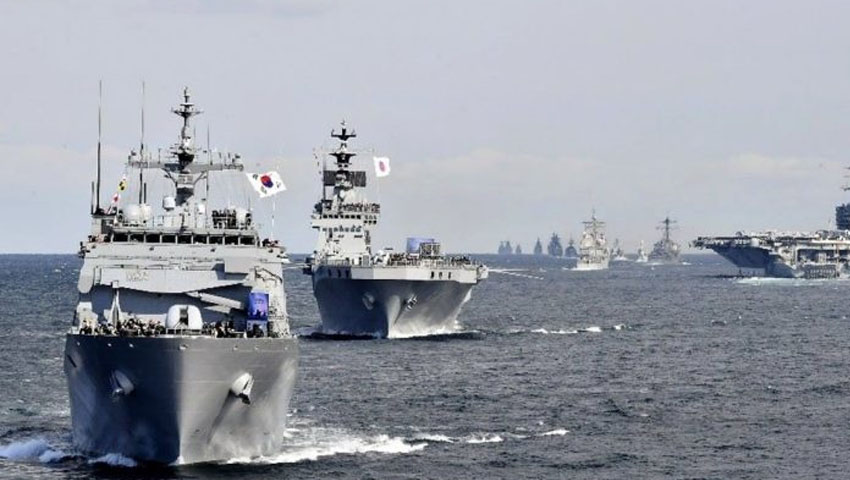South Korea has responded to the continuing challenges to Indo-Pacific stability and prosperity, particularly in the contested maritime domain, with the reveal of a range of next-generation capabilities, ranging from an aircraft carrier and arsenal ship to larger air defence destroyers and large, conventionally powered strategic deterrence submarines.
As both China and Japan surge ahead with plans to build potent aircraft carrier capabilities, South Korea has joined the race and announced plans to build a modified large-deck aircraft carrier based on the Republic of Korea Navy (ROKN) Dokdo Class amphibious warfare ships – seemingly leaving Australia as the only established Indo-Pacific power without a plan for a traditional, fixed-wing naval aviation and aircraft carrier capability.
At the end of the Second World War, the aircraft carrier emerged as the apex of naval prestige and power projection. Unlike their predecessor, the battleship, aircraft carriers in themselves are relatively benign actors, relying heavily a their attached carrier air-wings and supporting escort fleets of cruisers, destroyers and submarines to screen them from hostile action.
In recent years, nations throughout the Indo-Pacific have begun a series of naval expansion and modernisation programs with traditional aircraft carriers and large-deck, amphibious warfare ships serving as the core of their respective shift towards greater maritime power projection.
Driving this change is an unprecedented period of Chinese assertiveness in the South China Sea and the growing capabilities of the People's Liberation Army Navy (PLAN), which has seen the Chinese fielding or preparing to field a range of power projection capabilities, including aircraft carriers and supporting strike groups, fifth-generation combat aircraft, modernised land forces, area-access denial and strategic nuclear forces, combined with growing political and financial influence throughout the region.
Further adding to China's development of an increasingly capable aircraft carrier and fixed-wing naval aviation capability is China's ongoing construction of the Type 075 and Type 075A vessels, currently under construction at the Hudong-Zhonghua shipyards is designed to operate in a similar manner to the LHDs of the US, Australian, Japanese and South Korean navies.
These vessels are capable of providing amphibious power projection, sea-control and amphibious air support with an impressive helicopter complement and command and control capabilities – with a displacement of between 30,000-40,000 tons, the Type 075 also incorporates a floodable well-dock capable of supporting both Russian and Chinese designed landing craft air cushions (LCAC).
Korea's carrier
Building on this, the long-term threat from North Korea has prompted South Korea to embark on a series of land, air and sea acquisition programs that support the Republic of Korea's transition towards developing a robust, deployable, conventional power projection and deterrence focused force – at the core of this redevelopment is the planned construction of a 30,000-ton short take-off, vertical landing (STOVL) aircraft carrier.
This new vessel – which is expected to be double the size of the ROKN's two previous Dokdo Class, which weigh in at 14,500 tonnes of displacement – will serve as the basis for Korea's burgeoning carrier capability and will be slightly larger than Japan's Izumo Class vessels at 27,000 tonnes of displacement, which will be modified to accommodate a fleet of STOVL-variant F-35B Joint Strike Fighters beginning in the mid-2020s.
It is expected that the new vessel will accommodate up to 20 F-35Bs, in conjunction with 3,000 marines and 20 armoured vehicles – further supporting the power projection capabilities of the new vessel and the broad ROKN. This announcement fits in with the broader reorganisation of the ROKN – this new vessel is similar in size to the Royal Australian Navy's Canberra Class amphibious warfare ships: HMA Ships Canberra and Adelaide.

Serving in a complementary role in Korea's transition towards a blue water capable navy is the original Dokdo Class vessels, which will serve as the flagship in Korea's 'Rapid Response Fleet' structure. Korea has recently announced plans for three additional 7,600-tonne block two Sejong the Great Class Aegis guided missile destroyers worth a total of US$3.3 billion, to be completed by 2028 – these vessels are expected to serve part of Korea's broader integrated air and missile defence capabilities with a secondary focus on anti-surface and land attack capabilities.
New destroyers, arsenal ships and the long-range punch
The mid-term defence plan released by the Korean government reveals a 7.1 per cent increase in national defence expenditure between 2020 and 2024 with critical escort capable surface combatants serving as a key component of this enhanced maritime capability enhancement – the KDX-III is based on the existing Sejong the Great Class vessels and will from the onset be designed to counter the increasing ballistic missile capabilities of North Korea and increasingly the anti-access/area-denial (A2/AD) capabilities developed by China.

Additionally, Korea has initiated a further modification of its existing, locally designed and built KDX-II destroyers to develop a heavily armed arsenal ship incorporating a range of weapons systems, including precision guided missiles, for area-air and missile defence, ship-to-shore bombardment and surface combat to enhance the long-range strike capabilities of the ROKN.
This concept builds on a concept initially proposed by the US Navy in 1996 – the early concepts of the arsenal ship highlighted a ship with a comparatively small crew and as many as 500 vertical launch tubes to provide ship-to-shore bombardment and fire support for amphibious operations fulfilling the role traditionally occupied by the battleships of old and, to a limited extent, guided missile cruisers, destroyers and frigates.
Arsenal ships are designed to fulfil a unique role within the overall confines of contemporary naval doctrines and force structures. Such vessels when integrated as part of carrier or amphibious strike groups can also serve two roles – one of the supplementary air defence escort and the second being the long-range maritime strike for ship-to-shore and anti-ship roles.
A credible at-sea strategic deterrent
The very nature of South Korea's geographic location and the inherent volatility of the North Korean regime has necessitated the long-term development and maintenance of a credible strategic deterrent capability – submarines naturally fit this niche tactical and strategic capability. As a result, South Korea has invested heavily in this critical capability.
Korea's next-generation KSS III program marks the nation's entry into the elite club of the few nations globally that are capable of independently designing and building advanced submarines – the KSS III vessels in particular are large vessels with over 3,000 tonnes of displacement, an approximate length of 83.5 metres, maximum submerged speed of 20 knots, cruising range of 10,000 nautical miles and a crew of 50.
A key component of the KSS III program was the use of 10 vertical launch system (VLS) tubes, capable of launching a range of conventional long-range strike missiles, with endurance and stealth supported by improved South Korean designed lithium ion batteries and high-temperature superconductor (HTS) motor technologies supporting an integrated and full electric propulsion system.
Your thoughts
Korea's focus on establishing itself as a regional power capable of intervening in regional affairs serves as a model for Australian force structure planners – the comparable economic, political and demographic size of Australia and South Korea combined with the similarity in the platforms and systems operated by both nations serve as a building block for both interoperability and similar force structure models.
As an island nation, Australia is defined by its relationship with the ocean. Maritime power projection and sea control play a pivotal role in securing Australia’s economic and strategic security as a result of the intrinsic connection between the nation and Indo-Pacific Asia’s strategic sea-lines-of-communication in the 21st century.
Further compounding Australia's precarious position is an acceptance that 'Pax Americana', or the post-Second World War 'American Peace', is over and Australia will require a uniquely Australian approach and recognition that the nation is now solely responsible for the security of its national interests with key alliances serving a secondary, complementary role to the broader debate.
Increasingly, multi-domain air power plays an important role in the efficacy of naval forces and serves as a key component in both the force structure and capability development plans for both South Korea and Australia – these similarities support not only closer relationships between the two nations that share unique geo-political and strategic similarities but also provide the opportunity to develop robust force structures to respond to the rapidly evolving regional strategic environment.
Both fixed-wing naval aviation and amphibious capabilities are one of the key force multipliers reshaping the Indo-Pacific. The growing prevalence of fixed-wing naval aviation forces in particular serves to alter the strategic calculus and balance of power. Get involved with the discussion in the comments section below, or get in touch with



